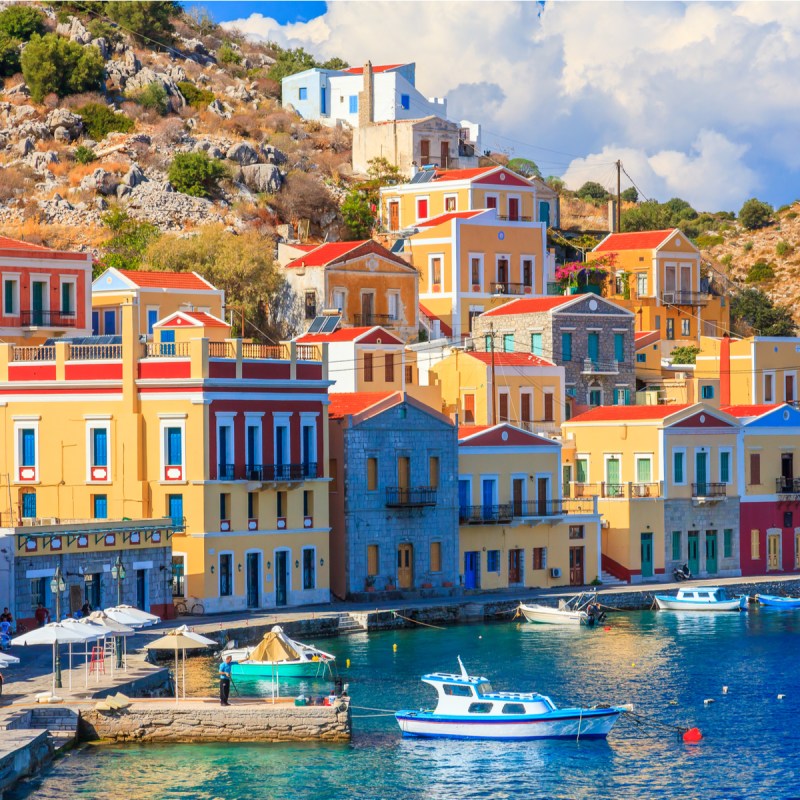
Before I get to list my favorite European cities with fewer crowds, my top tip is to avoid traveling to Europe during summer, especially in August. Instead, travel in the shoulder seasons (April-June and September-October) or even off-season (November-March, though remember that Christmas and the New Year are always busy). But I do understand that traveling out of season isn’t always possible. So if you are looking for some alternative European destinations, cities that fly under the radar but are just as special, then read on…
Videos by TravelAwaits

1. Symi, Greece
Greece is a perfect holiday destination. There are beaches galore, and you’ll find plenty to explore from history to boat trips and snorkeling. Fortunately, there are so many Greek islands that it’s relatively easy to find one free from crowds. Tucked between Rhodes and Kos, Symi is a world away from those tourist hotspots. Accessible only by ferry, you’ll arrive at one of the prettiest harbors in the world, with stunning pastel houses sprawling up the hillside. You can visit the island’s monastery, or take a bus up the hill to the little town. Little water “busses” cruise around the island, stopping at tiny coves which are only accessible from the water, and which have incredibly clear turquoise water. Many of these tiny beaches have a small tavern with delicious fresh fish. I can’t think of a better way to relax.

2. Thessaloniki, Greece
This is one of Greece’s best destinations for foodies, a melting pot of influences ranging from Arabia to Armenia. Restaurants here serve glorious gyros (meat cooked on a vertical rotisserie), flaky bougatsa (breakfast pastry), and inventive mezedes (appetizers). The market district is a labyrinth of tavernas and market stalls. There’s a promenade along the Aegean Sea and the upper town, called Ano Poli, which is full of crumbling Byzantine, Ottoman, and Roman buildings, many of which are World Heritage Sites. You could start your day on one of the local sandy beaches, and finish it watching the sunset over the harbor from the upper town.

3. Bologna, Italy
Bologna, Italy’s top gastronomic destination, has a charming red-brick old town of colonnaded squares. Piazza Maggiore is the heart of the old town, with a lively university district to the south, food-filled alleys to the east, and interesting churches and medieval towers. The university, home to 80,000 students, has a magnificent anatomical theatre dating back to 1637. Pinacoteca Nazionale (National Art Gallery) has a magnificent collection of artwork, which unlike elsewhere in Italy, is not so crowded that you are left peering over a sea of heads to see.
Pro Tip: Go in shoulder-season March or April for warm, sunny weather; December has fine Christmas markets.

4. Pitigliano, Italy
If you really want to find one of the best places in Tuscany without being shoulder-to-shoulder with the tourists of Florence or San Gimignano, then head a little further south and explore the town of Pitigliano. Located between the western coast and the town of Orvieto, Pitigliano is the place to go to explore small artisan shops or eat pizza under a shady tree; this is a town where you can explore the streets without worrying about getting lost in the crowds.
Pro Tip: Stay in a local Agriturismo (farm stay) like Le Sorgenti Agriturismo for a relaxing escape from the city.

5. Lyon, France
Lyon is a beautiful city of riverfronts, medieval streets, and café-filled squares. Less hurried and more laidback than Paris, this is the gastronomic capital of France. Beyond food, the city has a World Heritage-listed old town full of French Gothic and Renaissance buildings, plus a hilltop Roman amphitheater. There are no queues at the Musee des Beaux-Arts Lyon, which houses the biggest collection of Impressionist art outside of Paris. Lyon is also the birthplace of modern cinema, and the Musée Lumière celebrates the Lumière brothers, inventors of cinematography.
Pro Tip: I’d suggest staying between the Saône and Rhône rivers, in one of the 15 rooms at the Hotel Vaubecour.

6. Bordeaux, France
Arriving in Bordeaux, it is immediately apparent that you’ve arrived in the wine capital of the world. Before you hit the wineries, explore La Cite du Vin, an interactive museum dedicated to the history of wine production. The self-guided tour winds up on the 8th floor, where you can enjoy a glass of wine with some breath-taking views. Bordeaux is more than just grapes and fine wine though. There’s stunning gothic-style architecture, like the 15th-century Tour Pey Berland (the bell tower of the Bordeaux Cathedral). There’s also the city’s fabulous food and drink scene. Head to the west side of the river and café hop between Place de la Bourse and the Museum of Fine Arts, and then head to the Marché des Capucins (food market) to sample local cheese and wine – I’d recommend the oysters.

7. Elaphiti Islands, Croatia
Croatia has become popular in recent years, thanks in a large part to the series Game of Thrones. But while Dubrovnik is packed with tourists in the summer months, just a 40-minute ferry ride away are the quiet Elaphiti Islands. Kolocep and Lopud Islands are car-free, which makes for a pretty and peaceful paradise (you can get around by golf cart, but everything is within walking distance). Sunj Beach on Lopud Island has a shallow, sandy beach, where you can go snorkeling and see some pretty fish. For the more adventurous, you can go kayaking around the Elaphiti Islands, a great way to discover hidden bays and secluded beaches.
Pro Tip: There’s an underwater cave near Sipan Island, which can only be reached by kayak. Don’t miss it if you have the chance!

8. Lumbarda, Croatia
A little further from Dubrovnik is Korcula Island with its picturesque village Lumbarda. Lumbarda is 5 miles from historic Korcula Town and is a pretty, hilly village situated around a small harbor overlooking the Skoji Archipelago. There are several welcoming and friendly restaurants and bars which offer fabulous views of the Adriatic. You can rent bikes, paddle boards, and kayaks. The water is pristine, visibility for snorkeling is fantastic, and the sea is luxuriously warm for swimming. There’s also an easy coastal path where you can walk and enjoy beautiful views over the sea, especially at sunset.
Pro Tip: On a Friday evening, the village square hosts a Fisherman’s Market, where local people set up stalls selling wine, dinners (mostly fresh-caught fish), and delicious, local desserts.

9. Utrecht, Netherlands
How is it possible that the Netherland’s fourth-largest city is so relatively unknown? Only an hour’s train ride from Schiphol Airport and just half an hour from central Amsterdam, Utrecht is a relaxed alternative to Amsterdam, with similar architecture and canals, but none of the tourist tat or crowds. Compact and mostly pedestrian (though cyclists are everywhere), Utrecht is easily walked, with architectural treats and antiques dealers on every corner, and several splendid castles in the surrounding countryside. The town has a number of notable music festivals in the summer, and the Netherlands Film Festival is held here annually in autumn.
Pro Tip: Don’t miss climbing to the top of the 700-year-old Dom Tower for fabulous views over the gabled merchants’ houses and narrow canals of this quaint but buzzing city.

10. Valencia, Spain
Valencia, Spain’s third-largest city, is a 4-hour train trip from Barcelona, yet has much fewer visitors. Great for shopping and home to a fascinating science museum, aquarium, and opera house, Valencia also has fantastic, inventive restaurants, and streets filled with locals rather than just tourists. Walk through the city to see medieval buildings, art deco apartments, and the Turia Gardens which meander through the center of town. Valencia Cathedral is a Gothic masterpiece opened in 1262, Museo de Bellas Artes houses 2,000 artworks dating from the 14th through 17th centuries, and Mercado Central is one of the country’s best food markets.

11. Frigiliana, Spain
When thinking of visiting Spain in summer, you might be picturing beaches filled with sun beds and umbrellas, all-inclusive hotels, and streets lined with Irish bars. But look further afield and you can find some really special places off the beaten path, like the picturesque area of Frigiliana. Described as the “prettiest village in Andalusia” by the Spanish tourism authority, this quaint area is only a few minutes’ drive from the hustle and bustle of Marbella, yet it seems a world away. It has a traditional Spanish vibe, with no big hotels and no tourist crowds. There are many nearby tourist attractions, like hiking in the Sierra Nevada mountains (the impressive hanging bridges are fun), visiting the nearby Caves of Nerja (caverns that stretch underground for almost 3.5 miles), or going to see how the “other half” live in Puerto Banus (the Costa del Sol’s playground for the rich and famous, and the most expensive leisure port in Europe).

12. Stuttgart, Germany
Stuttgart is a city that packs a punch without the swarms of tourists you’ll find in the nearby cities of Munich and Frankfurt. The Schlossplatz (Palace Square) is the vibrant heart of the city, with the baroque palace standing regally in the background. Killesberg Hill Park is the green oasis in the middle of the city where you can enjoy the Biergardens or climb to the top of the Killesberg tower for views of the city below. For the car aficionados, there are two car museums (Porsche and Mercedes Benz) to keep you busy. Stuttgart is also the perfect jumping-off point for visiting other small towns in the area, such as the famous Triberg with its waterfall, black forest clocks, and cake.
Pro Tip: A good place to stay is the centrally located Maritim Hotel.

13. Graz, Austria
Graz is Austria‘s second-largest city but is little-known to many. Only a 2 and a half hour scenic train ride from Vienna, this city, with a population of 270,000, has none of Vienna’s pretensions, yet still has enough history and culture to be interesting. The Renaissance old town is lived in with shopping streets such as Herrengasse and Sporgasse winding their way through the town. Above, walking paths and battlements on Schlossberg rock provide some impressive views, and the Styrian Armory (the world’s largest collection of arms and armor) is surprisingly interesting.
And there you have it, my suggestions for some alternative European destinations that you can head for when you want to escape the crowds but don’t want to miss out on a fantastic European vacation.

